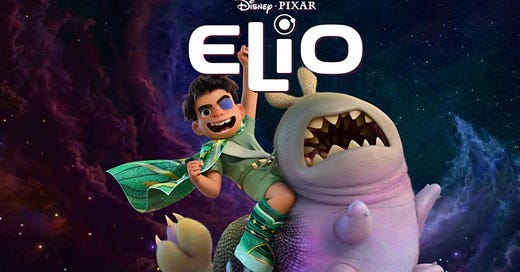"Elio" Provides More Life-Lessons, This Time in Galactic Rainbows
My continuing unease with the Pixar brand is that they routinely bring me back to childhood Sunday School, a place I dreaded. There we sat on cold metal chairs learning life’s apparently greatest lessons, such as how to be a good person. I preferred watching Sunday morning WWF.
In Elio, the flavor of the lesson is potpourri science-fiction.
The blank protagonist of the title, a young orphan boy, must undergo space adventures to realize how much he loves Earth and that he should enjoy living with his aunt.
He’s a new orphan, and the aunt’s having trouble connecting with him. There’s your essential Pixar relationship problem.
We know little else about this movie’s heroic pair. The Pixar team has stripped human particulars almost entirely from their blank-slate characters. Why bother caring about characters who can’t fill out more than two ID fields in a social-media profile?
Well, if you do not, you can at least care about this movie’s other agenda — the search for intelligent life in the universe. I was not prepared for Elio’s Contact-style message about the necessity of intergalactic searching for ETs.
This comes complete with a lesson in the film on what Voyager 1 is and what its mission is. At the end of the film, a Carl-Sagan voiceover encourages us to seek aliens so that we can discover if we are alone or not in the universe.
In the beginning of the film, Elio seeks aliens because he feels alone on Earth. He’s in a Pixar movie, though. Reconciliation is key to all, so you are never, of course, alone.
I’ve described the movie this way because this is its core, all the way through. Storywise, you will experience a new plot maneuver every five minutes. These include the use of alien abduction, liquid supercomputers, cloning, universal translators, a prison-break, Elio piloting a spaceship, and ham-radio operators uniting to save the world or something.
At first Elio longs to be abducted by aliens, since his parents are now dead, but he’s bullied by older kids for awhile. Frustrated with his reticence, his aunt abandons him at summer camp.
Once he’s abducted by aliens there, he’s off to the — and now I will sound like I’m on drugs — the pangalactic Communiverse, a multi-alien wonderworld of open-mindedness and tolerance. It’s being attacked, however, by Lord Grigon and his aggressive race of carapace-wearing slug warriors. Elio must act as Earth’s ambassador to get accepted into the Communiverse. This requires him to properly negotiate peace with Grigon.
Back on Earth, Elio’s aunt is fooled into thinking Elio has changed, because the Communiverse has created a perfect clone of him. Up in space, Elio’s trying to figure out how to pretend to be the leader of Earth and get accepted into the Communiverse.
A better movie might consider whether deceiving others to get what he wants, as Elio does multiple times, has philosophical and moral justifications or not. This movie, however, waves that away in favor of Elio’s need to relate to his aunt and, as a secondary matter, Lord Grigon’s need to relate to his more peaceful son (who is the space-slug in the image above, the most fun character in the film).
As I mentioned above, why should anybody bother caring about Elio, though? He’s got one personal problem, his desire to escape Earth, and no defining characteristics. What’s his backstory? Where is he from? What does he prefer for breakfast? What’s his favorite subject in school?
Add to that the lack of care in designing the backstory of the movie’s spaceworld. Why should we care about the Communiverse? Where did it come from? What does it do? Where did the Grigons come from and why are they doing what they are doing?
No character or place matters in Elio, as particular characters or places. Only the viewer’s experience of a general relational problem and its resolution counts. At this point in Pixar history, it doesn’t matter if a warrior space-slug needs to relate to a talking ostrich. The kids are going to get a lesson in elementary psychology.,
But perhaps the action is in the movie’s gee-whiz wonders? I did take some delight in recognizing the science-fictional homages, the best of which involves Elio’s clone referencing The Thing. The meetup of Grigon’s son and Elio will remind you of the Alien franchise.
Still, I have trouble with Pixar’s choice of aesthetics to represent its life lessons. The movie’s general color scheme, at least for the second act in outer space, is toy-aisle bright. That codes as “kiddie.” The movie’s psychological questions are aimed higher, at adolescents.
Its cosmological efforts to make us feel awe at Voyager and Carl Sagan feel to me at odds with the other matters of the movie.
While better recent films like The Wild Robot and Flow have creatively ventured into pastels and impressionist-style animation, Pixar continues to push big-eyed, baby-looking characters surrounded by brighter primary colors. They have not innovated aesthetically in a long while.
Elio might introduce very young viewers to key science-fictional concepts, including what Voyager 1 is and why it was launched. It doesn’t feel honest to me, never quite believing in and loving the particular film-world it offers up.
Rather than hear another abstract moral lesson, maybe I was just interested today in seeing space-slugs blow stuff up. More slugs!





